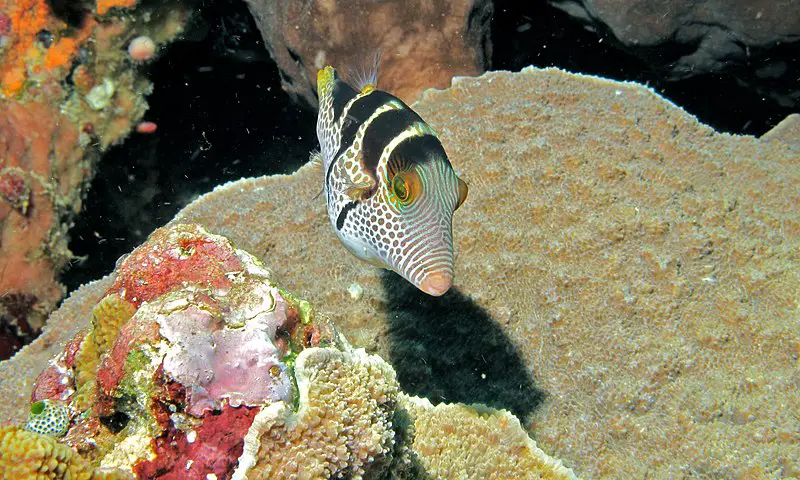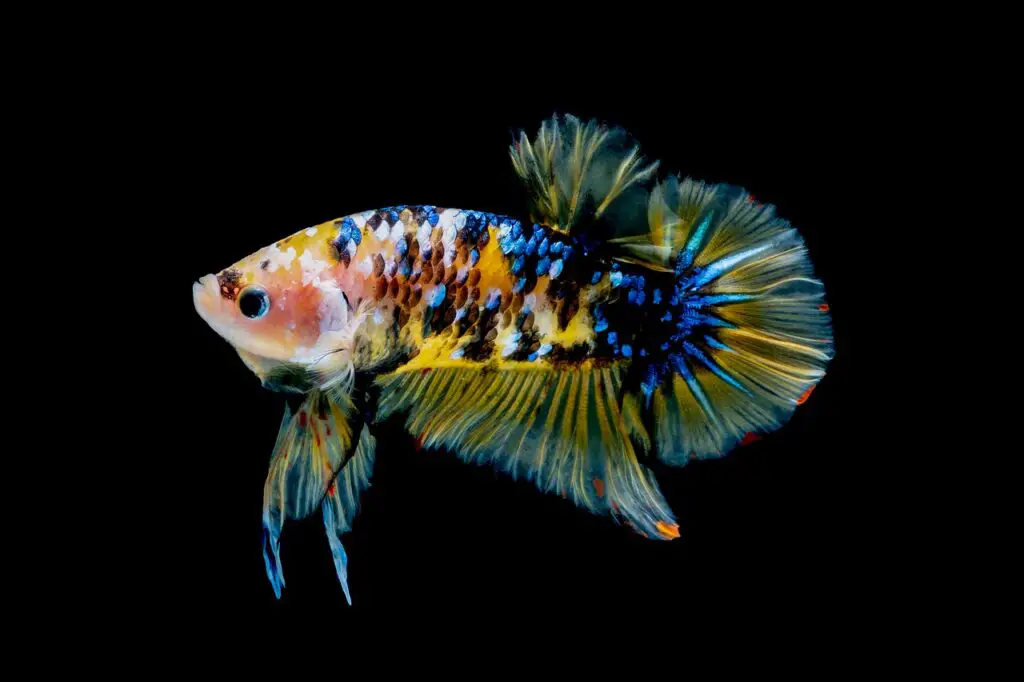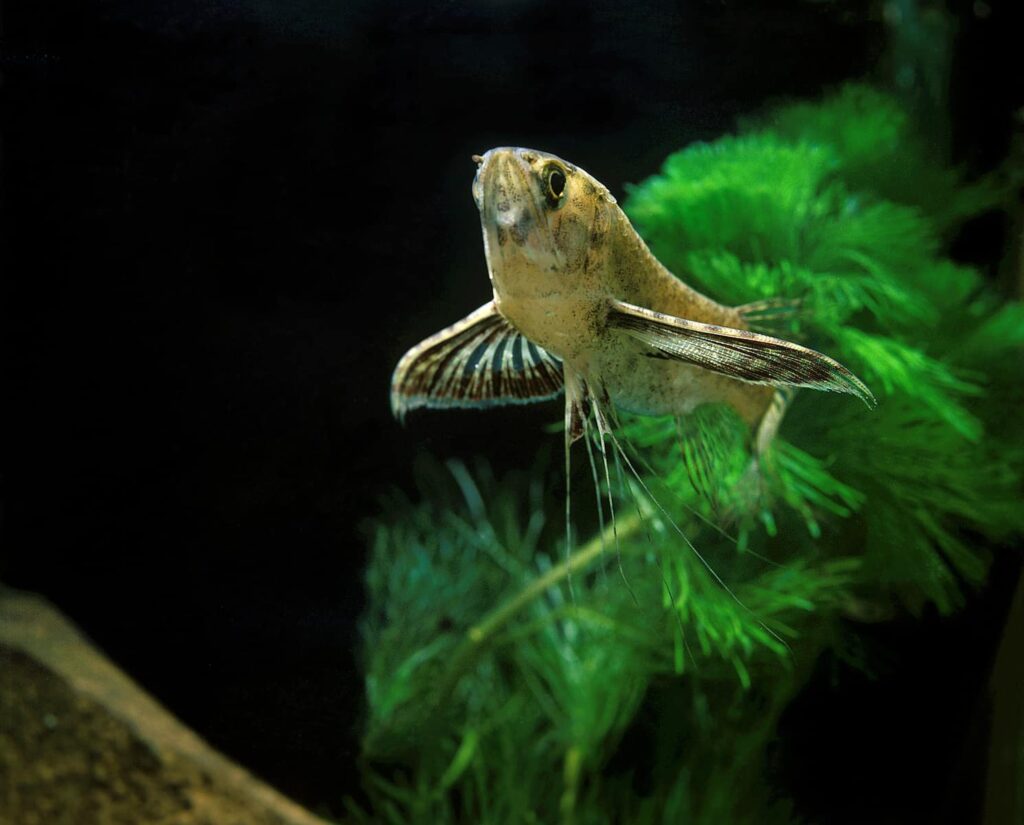The Valentini sharpnose puffer, also known as the black saddled toby, sharpnose puffer, or saddled puffer, is a small, brightly colored species of pufferfish that coexists well with clownfish as tank mates. While semi-aggressive in nature, these puffers coexist well with a variety of other tank mates, including tangs, gobies, and and angelfish.
Avoid adding smaller fish and those with long, flowing fins with your puffer, as these fish have the tendency to nip. Valentini puffers are not reef safe, as these fish will nip at corals and other invertebrates.
The rest of this article will tell you all you need to know about your Valentini puffer and what species are ideal tank mates.
What are Valentini Pufferfish?
Valentini pufferfish (Canthigastar valentini) are a small species of pufferfish with unique colors and markings. Both males and females are cream-colored, with yellow spots and tailfin, with four black saddle-shaped stripes on its back. The presence and appearance of these black stripes lend to one of this puffer’s many names, the saddled puffer.
Another common name for this fish is the sharpnose pufferfish, named for its elongated, beak-like snout.
It is native to the tropical and subtropical waters of the Indian and Pacific Oceans, and is most often found among lagoons and coral reefs.
Can I put Pufferfish with Clownfish?
Valentini pufferfish thrive with having clownfish as tank mates. While Valentini pufferfish can be aggressive with other species of fish, clownfish are fast and have short fins, reducing any temptation the puffers might have in attacking them.
Since both Valentini pufferfish and clownfish sport bright colors and striking patterns, they offer an appealing aesthetic to any aquarium.
What Fish Can Live with Valentini Puffer?
Don’t put slow-moving fish or fish with long fins in the same tank as a Valentini puffer because the puffer is semi-aggressive and will nip at the fins of these fish.
Other fish species that live well with the Valentini puffer are listed below:
- Tangs
- Angelfish
- Butterfly Fish
- Hermit crabs
- Snails
- Gobies
- Chromis
To reduce aggression in your Valentini puffer, make sure to feed it a healthy, varied diet and provide plenty of shelter like rock structures, aquatic plants, and other tank decor.
Be sure to provide at least a 30 gallon tank and avoid overcrowding your aquarium. However, some experts emphasize that 50 gallons should be the minimum tank size for your puffer. Bigger is definitely better when it comes to the Valentini pufferfish.
A good rule of thumb for gauging how many fish you can fit in the tank is to provide a minimum of 10 gallons of water per fish in your aquarium.
What Should I Avoid Adding to my Puffer’s Tank?
In general, Valentini puffers can live with a wide variety of different fish, as long as the other species sharing the tank are as big as or nearly as big as the puffer. Avoid small or slow-moving fish or fish with long, flowy fins.
If you choose to add crabs or snails to your aquarium, you might notice your puffer nipping at them. However, snails will naturally retreat into their shells during the attack while crabs might pinch and harm your puffer.
Any tank cleaners, such as shrimp, are generally poor tank mates for Valentini puffers, as puffers usually go after small, tasty prey such as these.
Can More than One Valentini Puffer Share a Tank?
Whether or not your puffer can tolerate another puffer in its domain is usually up to your fish’s individual disposition. In nature, these puffers typically form harems of one male and 2 – 3 females.
Experts suggest never placing two males in the same aquarium. Two females will usually coexist peacefully, and in some instances, one male and two females will share a tank well, especially if you plan on breeding them.
Is a Valentini Puffer Reef Safe?
The Valentini puffer is not reef safe, because it has a natural inclination to nip and nibble at corals and other invertebrates, which will damage the reef.
This trait applies to all species of pufferfish.
Are Valentini Puffers Hardy?
Pufferfish don’t have scales, which means they can be quite sensitive to any fluctuations in water quality or pH. The ideal pH for your puffer’s tank should range between 8.1 – 8.4. The temperature should always remain between 72 – 78 degrees Fahrenheit.
What Should I Feed my Valentini Puffer?
Valentini puffers are omnivores, so make sure to feed them a varied diet. They especially like chunks of meat, such as clams, mussels, squid, and raw table shrimp. Also supplement with plant-based food, such as krill, nori, or algae pellets so you are fully meeting their nutritional needs.
Despite Valentini puffers’ small, comical mouths, they have powerful jaws and sharp teeth – ideal for chewing large chunks of meat and prying open mollusks.
One of the major issues with maintaining your Valentini puffer’s health is their teeth, which never stop growing. If you don’t feed your puffer food to wear down their teeth, overgrown teeth can pose a problem for your puffer and damage their mouth.
To remedy this issue, feed your Valentini puffer a diet rich in shelled foods, such as clams and mollusks, as these will wear down their teeth and keep them at a manageable size.
Puffers love algae, and have the jaws and teeth necessary to scrape algae from rocks and other aquarium decor. When cleaning the tank, make sure to leave a few patches of algae to supplement your puffer’s diet.
Your puffer needs to eat frequently, about 2 – 3 times a day.
How Big Does a Valentini Puffer Get?
Valentini pufferfish are one of the smallest varieties of pufferfish. They are popular additions to aquariums, as most pufferfish species are too large to fit in any aquarium smaller than 100 gallons.
Valentini pufferfish usually only grow to a length of 4 or 4 1/2 inches. There have been cases where they’ve grown larger, but these instances are extremely rare.



